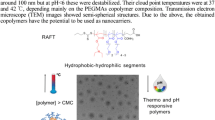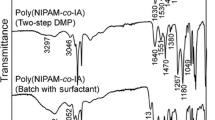Abstract
The loading properties of ibuprofen (IBU) were investigated using poly(N-isopropylacrylamide-co-acrylic acid) P(NIPAM-co-AA) copolymer nanoparticles as a carrier. Subsequently, the sensitivity of controlled release performance during changing external conditions and composition of copolymer were evaluated in detail. The results showed that the introduction of AA chains into PNIPAM framework enhanced the loading of IBU and the maximum loading capability of P(NIPAM-co-AA)-3 reached up to 7.9 wt%. The release behaviors of IBU-loaded copolymers exhibited high responsiveness to temperature and pH values. For example, P(NIPAM-co-AA)-10 exhibited a high cumulative release amount of 83.2% at 37 °C/pH 7.4, and a significant decrease in the release amount of 32.2% at 37 °C/pH 2.0. The influence of various amounts of acrylic acid (AA) and salt effect (ionic strength) on the swelling behaviors were demonstrated via dynamic light scattering method. Their microstructures and morphologies were characterized using scanning electron microscopy (SEM), transmission electron microscopy (TEM) and small-angle X-ray scattering (SAXS) techniques, which confirmed the presence of fractal structures with D m (2.65–2.87) or D s (2.0–2.33). These results further suggested that the structural evolution of P(NIPAM-co-AA) copolymer with increasing AA content had occurred from loose networks to dense aggregates with statistical self-similarity. The IBU-release mechanism was proposed, whereas the IBU diffusion contribution from P(NIPAM-co-AA) was thoroughly elucidated using three empirical equations, namely Korsmeyer–Peppas model, modified Korsmeyer–Peppas model and Higuchi model, respectively. The obtained results demonstrated that the release procedure of P(NIPAM-co-AA) was driven by typical non-Fickian diffusion mechanism in the basic medium, while in acid medium a two-stage release mechanism was observed due to their aggregation behaviors.
Graphical abstract








Similar content being viewed by others
References
Díez-Peña E, Quijada-Garrido I, Barrales-Rienda JM, Schnell I, Spiess HW (2004) The formation of hydrogen bonds in hydrogels based on N-isopropylacrylamide (NiPAAm) and methacrylic acid (MAA). Macromol Chem Phys 205:438–447
Karg M, Pastoriza-Santos I, Rodriguez-González B (2008) Temperature, pH, and ionic strength induced changes of the swelling behavior of PNIPAM-poly(allylacetic acid) copolymer microgels. Langmuir 24:6300–6306
Ninni L, Ermatchkov V, Hasse H, Maure G (2014) Swelling behavior of chemically cross-linked poly(N-IPAAm-allylglycine) hydrogels: effects of NaCl and pH. Fluid Phase Equilib 361:257–265
Némethy Á, Solti K, Kiss L, Gyarmat B, Deli MA, Csányi E, Szilágyi A (2013) pH- and temperature-responsive poly(aspartic acid)-l-poly(N-isopropylacrylamide) conetwork hydrogel. Eur Polym J 49:2392–2403
Constantin M, Bucatariu S, Harabagiu V, Popescu I, Ascenzi P, Fundueanu G (2014) Poly(N-isopropylacrylamide-co-methacrylic acid) pH/thermo-responsive porous hydrogels as self-regulated drug delivery system. Eur J Pharm Sci 62:86–95
Chen SL, Liu MZ, Jin SP, Chen Y (2014) pH-/temperature-sensitive carboxymethyl chitosan/poly(N-isopropylacrylamide-co-methacrylic acid) IPN: preparation, characterization and sustained release of riboflavin. Polym Bull 71:719–734
Park JS, Yang HN, Woo DG, Jeon SY, Park KH (2013) Poly(N-isopropylacrylamide-co-acrylic acid) nanogels for tracing and delivering genes to human mesenchymal stem cells. Biomaterials 34:8819–8834
Prasannan A, Tsai HC, Chen YS, Hsiue GH (2014) A thermally triggered in situ hydrogel from poly(acrylic acid-co-N-isopropylacrylamide) for controlled release of anti-glaucoma drugs. J Mater Chem B 2:1988–1997
Johnson RP, Jeong Y, John JV, Chung CW, Kang DH, Selvaraj M, Suh H, Kim I (2013) Dual stimuli-responsive poly(N-isopropylacrylamide)-b-poly (l-histidine) chimeric materials for the controlled delivery of doxorubicin into liver carcinoma. Biomacromolecules 14:1434–1443
Taşdelen B, Kayaman-Apohan N, Güvenc O, Baysal BM (2005) Anticancer drug release from poly(N-isopropylacrylamide/itaconic acid) copolymeric hydrogels. Radiat Phys Chem 73:340–345
Xu TW, He BL (1998) Mechanism of sustained drug release in diffusion-controlled polymer matrix-application of percolation theory. Int J Pharm 170:139–149
Craig DQM (2002) The mechanisms of drug release from solid dispersions in water-soluble polymers. Int J Pharm 231:131–144
McGint S, McKee S (2015) Release mechanism and parameter estimation in drug-eluting stent systems: analytical solutions of drug release and tissue transport. Math Med Biol 32:163–186
Díez-Peña E, Frutos P, Frutos G, Quijada-Garrido I, Barrales-Rienda JM (2004) The influence of the copolymer composition on the diltiazem hydrochloride release from a series of pH-sensitive poly[(N-isopropylacrylamide)-co-(methacrylic acid)] hydrogels. AAPS Pharm Sci Tech 5:1–8
Sousa RG, Prior-Cabanillas A, Quijada-Garrido I, Barrales-Rienda JM (2005) Dependence of copolymer composition, swelling history, and drug concentration on the loading of diltiazem hydrochloride (DIL.HCl) into poly[(N-isopropylacrylamide)-co-(methacrylic acid)] hydrogels and its release behaviour from hydrogel slabs. J Control Release 102:595–606
Bekhradnia S, Zhu KZ, Knudsen KD, Sande SA, Nyström B (2014) Structure, swelling, and drug release of thermoresponsive poly(amidoamine) dendrimer-poly(N-isopropylacrylamide) hydrogels. J Mater Sci 49:6102–6110
Milašinović N, Krušić MK, Knezevic-Jugovi Z, Filipovi J (2010) Hydrogels of N-isopropylacrylamide copolymers with controlled release of a model protein. Int J Pharm 383:53–61
Bai SY, Zhang H, Sun JH, Han J, Guo YY (2014) Preparation and pH-responsive performance of silane-modified poly(methylacrylic acid). J Appl Poly Sci 131:40403
Guo YY, Sun JH pH-sensitive performance of dextran-poly (acrylic acid) copolymer and its application as a controlled ibuprofen delivery. Int J Polym Mater Polym Biomaterials (In press)
Shibayama M (2006) Universality and specificity of polymer gels viewed by scattering methods. Bull Chem Soc Jpn 79:1799–1819
Chalal M, Ehrburger-Dolle F, Morfin I, Bley F, Aguilar de Armas MR, Donaire MLL, Roman JS, Bőolgen Nimet, Pişkin E, Ziane O, Casalegno R (2010) SAXS investigation of the effect of temperature on the multiscale structure of a macroporous poly(N-isopropylacrylamide) gel. Macromolecules 43:2009–2017
Varga N, Benkő M, Sebők D, Dékány I (2014) BSA/polyelectrolyte core–shell nanoparticles for controlled release of encapsulated ibuprofen. Colloids Sur B Biointerfaces 123:616–622
Su SS, Wang H, Liu XG, Wu Y, Nie GJ (2013) iRGD-coupled responsive fluorescent nanogel for targeted drug delivery. Biomaterials 34:3523–3533
Zhang H, Bai SY, Sun JH, Han J, Guo YY (2014) pH-responsive ibuprofen delivery in silane-modified poly (methylacrylic acid) coated bimodal mesoporous silicas. Mater Res Bull 53:266–271
Li ZM, Wang YJ, Shen J, Liu W, Sun XM (2014) The measurement system of nanoparticle size distribution from dynamic light scattering data. Opt Lasers Eng 56:94–98
Höfl S, Zitzler L, Hellweg T, Herminghaus S, Mugele F (2007) Volume phase transition of ‘‘smart’’ microgels in bulk solution and adsorbed at an interface: a combined AFM, dynamic light, and small angle neutron scattering study. Polymer 48:245–254
Bolisetty S, Hoffmann M, Lekkala S, Hellweg Th, Ballauff M, Harnau L (2009) Coupling of rotational motion with shape fluctuations of core-shell microgels having tunable softness. Macromolecules 42:1264–1269
Hajji P, David L, Gerar JF, Pascault JP, Vigierg I (1999) Synthesis, structure, and morphology of polymer–silica hybrid nanocomposites based on hydroxyethyl methacrylate. J Polym Sci B Polym Phys 37:3172–3187
Costa P, Sousa Lobo JM (2001) Modeling and comparison of dissolution profiles. Eur J Pharm Sci 13:123–133
Chakraborty S, Mitra MK, Chaudhuri MG, Das B, Sa S, Dey R (2012) Study of the release mechanism of terminalia chebula extract from nanoporous silica gel. Appl Biochem Biotechnol 168:2043–2056
Kuang Y, Zhao L, Zhang S, Zhang F, Dong M, Xu S (2010) Morphologies, preparations and applications of layered double hydroxide micro-/nanostructures. Materials 3:5220–5235
Kim H, Fassihi R (1997) Application of binary polymer system in drug release rate modulation. 2. Influence of formulation variables and hydrodynamic conditions on release kinetics. J Pharm Sci 86:323–328
Cost FO, Sous JJS, Pais AACC, Formosinho SJ (2003) Comparison of dissolution profiles of ibuprofen pellets. J Control Release 89:199–212
Siepmann J, Peppas NA (2001) Modeling of drug release from delivery systems based on hydroxypropyl methylcellulose (HPMC). Adv Drug Deliv Rev 48:139–157
Zhu YF, Shi JL, Li YS, Chen HR, Shen WH, Dong XP (2005) Storage and release of ibuprofen drug molecules in hollow mesoporous silica spheres with modified pore surface. Micropor Mesopor Mater 85:75–81
Viitala R, Jokinen M, Rosenholm JB (2007) Mechanistic studies on release of large and small molecules from biodegradable SiO2. Int J Pharm 336:382–390
Parfenyuk EV, Dolinina ES (2014) Design of silica carrier for controlled release of molsidomine: effect of preparation methods of silica matrixes and their composites with molsidomine on the drug release kinetics in vitro. Eur J Pharm Biopharm 88:1038–1045
Lindner WD, Lippold BC (1995) Drug release from hydrocolloid embeddings with high or low susceptibility to hydrodynamic stress. Pharm Res 12:1781–1785
Curcio M, Spizzirri UG, Iemma F, Puoci F, Cirillo G, Parisi OI, Picci N (2010) Grafted thermo-responsive gelatin microspheres as delivery systems in triggered drug release. Eur J Pharm Biopharm 76:48–55
Zeeshan A, Gooding EA, Pimenov KV, Wang LL, Asher SA (2009) UV resonance Raman determination of molecular mechanism of poly(N-isopropylacryl -amide) volume phase transition. J Phys Chem B 113:4248–4256
Ende MTA, Peppas NA (1996) Transport of ionizable drugs and proteins in crosslinked poly(acrylic acid) and poly(acry1ic acid-co-2-hydroxyethyl methacrylate) hydrogels. 1. Polymer characterization. J Appl Polym Sci 59:673–685
Mortera R, Fiorilli S, Garrone E, Verné E, Onida B (2010) Pores occlusion in MCM-41 spheres immersed in SBF and the effect on ibuprofen delivery kinetics: a quantitative model. Chem Eng J 156:184–192
Kocbek P, Baumgartner S, Kristl J (2006) Preparation and evaluation of nanosuspensions for enhancing the dissolution of poorly soluble drugs. Int J Pharm 312:179–186
Sitta Danielly LA, Guilherme MR, Silva EP, Valente AJM, Muniz EC, Rubira AF (2014) Drug release mechanisms of chemically cross-linked albumin microparticles: effect of the matrix erosion. Colloids Surf B Biointerfaces 122:404–413
Dowding PJ, Vincent B, Williams E (2000) Preparation and swelling properties of poly(NIPAM) “minigel” particles prepared by inverse suspension polymerization. J Colloid Interface Sci 221:268–272
Snowden MJ, Chowdhry BZ, Vincent B, Morris GE (1996) Colloidal copolymer microgels of N-isopropylacrylamide and acrylic acid: pH, ionic strength and temperature effects. J Chem Soc Faraday Trans 92:5013–5016
Kratz K, Hellweg T, Eimer W (2000) Influence of charge density on the swelling of colloidal poly(N-isopropylacrylamide-co-acrylic acid) microgels. Colloids Surf A Physicochem Eng Asp 170:137–149
Hall RJ, Pinkrah VT, Chowdhry BZ, Snowden MJ (2004) Heteroaggregation studies of mixed cationic co-polymer/anionic homopolymer microgel dispersions. Colloids Surf A Physicochem Eng Asp 233:25–38
Khan MS, Khan GT, Khan A, Sultana S (2013) Preparation and characterization of novel temperature and pH sensitive (NIPAM-co-MAA) polymer microgels and their volume phase change with various salts. Polymer (Korea) 37:794–801
Farooqi ZH, Khan HU, Shah SM, Siddi M (2013) Stability of poly (N-isopropyl acrylamide-co-acrylicacid) polymer microgels under various conditions of temperature, pH and salt concentration. Arab J Chem. doi:10.1016/j.arabjc.2013.07.031
Hahn A, Brandes G, Wagener P, Barcikowski S (2011) Metal ion release kinetics from nanoparticle silicone composites. J Control Release 154:164–170
Asrar J, Ding Y, Monica RE, Ness LC (2004) Controlled release of tebuconazole from a polymer matrix microparticle: release kinetics and length of efficacy. J Agric Food Chem 52:4814–4820
Zhou J, Pishko MV, Lutkenhaus JL (2014) Thermoresponsive layer-by-layer assemblies for nanoparticle-based drug delivery. Langmuir 30:5903–5910
Acknowledgements
This project was supported by the National Natural Science Foundation of China (21276005 and 21576005), and the Beijing Municipal Natural Science Foundation (2152005).
Author information
Authors and Affiliations
Corresponding author
Electronic supplementary material
Below is the link to the electronic supplementary material.
Rights and permissions
About this article
Cite this article
Jin, X., Wang, Q., Sun, J. et al. Dual temperature- and pH-responsive ibuprofen delivery from poly(N-isopropylacrylamide-co-acrylic acid) nanoparticles and their fractal features. Polym. Bull. 74, 3619–3638 (2017). https://doi.org/10.1007/s00289-017-1915-4
Received:
Revised:
Accepted:
Published:
Issue Date:
DOI: https://doi.org/10.1007/s00289-017-1915-4




